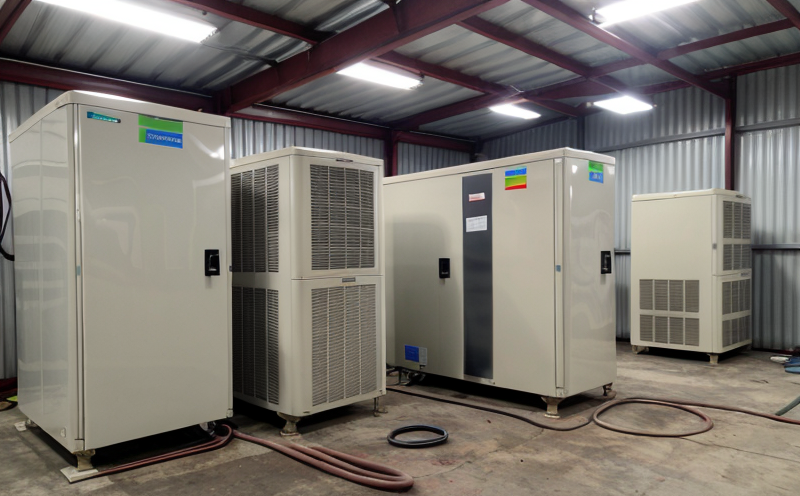EN 378-2 Refrigerant Leakage and Containment Testing
The EN 378 series of standards is dedicated to refrigerants used in air conditioning and refrigeration systems. The specific test outlined in EN 378-2 focuses on the leakage and containment performance of these refrigerants. This standard is crucial for ensuring that the refrigerant systems are safe, efficient, and environmentally friendly.
The testing procedure described in EN 378-2 involves a series of steps designed to evaluate the integrity of a refrigerant system under various conditions. This includes pressurizing the system with an inert gas or refrigerant, then monitoring for any loss of pressure over time. The test helps identify potential leaks and assesses the containment characteristics of the refrigerant, which are critical in preventing environmental damage from leaks.
The significance of this test cannot be overstated. Refrigerants like HFCs (hydrofluorocarbons) and PFCs (perfluorocarbons) have a significant global warming potential. A small leak can lead to substantial environmental harm, making the ability to detect and mitigate such leaks essential for sustainable practices.
The testing procedure outlined in EN 378-2 is designed to be rigorous yet practical, ensuring that it can be implemented in various settings from large industrial plants to smaller commercial units. The test parameters are carefully defined, allowing for consistent and reliable results across different systems.
Specimen preparation involves filling the system with a known amount of refrigerant, typically HFC-134a or R1234yf, depending on the application. After pressurizing the system, it is left to stabilize before monitoring begins. The monitoring period can vary based on the type and size of the system being tested.
The instrumentation used in this test includes pressure gauges, mass flow meters, and sometimes specialized leak detectors. These tools help in accurately measuring the rate of pressure drop over time. Reporting involves documenting these measurements alongside any visual observations during the testing process.
A successful outcome indicates that the system is both leak-tight and capable of containing the refrigerant under typical operating conditions. This ensures that systems are not only safe for use but also environmentally responsible, aligning with broader sustainability goals.
In summary, EN 378-2 plays a vital role in ensuring the integrity and environmental responsibility of refrigerant systems. By identifying leaks early and accurately, this test helps prevent potential environmental harm and supports sustainable practices.
Why It Matters
The importance of EN 378-2 testing cannot be understated given the critical role that refrigerants play in modern HVAC systems. Refrigerants are not only essential for cooling and heating but also have a significant impact on environmental sustainability.
- Reduction of Greenhouse Gas Emissions: By ensuring that refrigerant systems do not leak, we reduce the release of potent greenhouse gases into the atmosphere.
- Enhanced System Efficiency: Leaks can lead to reduced system performance and increased energy consumption. Testing helps maintain optimal efficiency levels.
- Safety Compliance: Leakage testing is a regulatory requirement in many regions, ensuring that systems meet strict safety standards.
- Economic Benefits: Preventing leaks not only protects the environment but also saves on replacement costs and maintenance expenses.
The global shift towards more sustainable practices means that HVAC equipment must be designed with environmental considerations in mind. Testing for leakage is a key component of this effort, ensuring that systems are both safe and efficient.
Customer Impact and Satisfaction
Clients who undergo EN 378-2 testing can expect several benefits that translate directly into increased customer satisfaction:
- Enhanced Product Quality: By ensuring compliance with international standards, customers receive products that are not only reliable but also environmentally responsible.
- Regulatory Compliance: Many regions mandate compliance with standards like EN 378-2. Testing ensures that clients meet these requirements, avoiding potential legal issues and penalties.
- Increased Customer Trust: Demonstrating commitment to environmental responsibility builds trust and enhances the reputation of the client.
- Better Value for Money: By identifying and addressing leaks early in the process, clients avoid costly repairs and replacements down the line.
Clients also benefit from having access to detailed reports that provide a comprehensive overview of system performance. These reports can be used as part of ongoing maintenance plans or to support future product improvements.
By investing in EN 378-2 testing, clients not only meet regulatory requirements but also contribute to broader sustainability goals. This commitment to environmental responsibility is increasingly valued by customers and stakeholders alike.
Environmental and Sustainability Contributions
The implementation of EN 378-2 testing contributes significantly to environmental conservation efforts:
- Reduction in Greenhouse Gas Emissions: By preventing leaks, this test helps reduce the release of potent greenhouse gases into the atmosphere.
- Sustainable Resource Use: Ensuring that refrigerant systems are leak-free minimizes resource wastage and supports efficient use of resources.
- Better Air Quality: Leaks can lead to the release of harmful compounds, which contribute to poor air quality. Testing helps mitigate this issue.
- Support for Sustainable Development Goals: By aligning with international standards like EN 378-2, clients play a role in supporting global sustainability goals.
The environmental and sustainability contributions of EN 378-2 testing are not just theoretical; they have real-world impacts. By reducing leaks, clients help protect the environment while also contributing to broader sustainability efforts.





